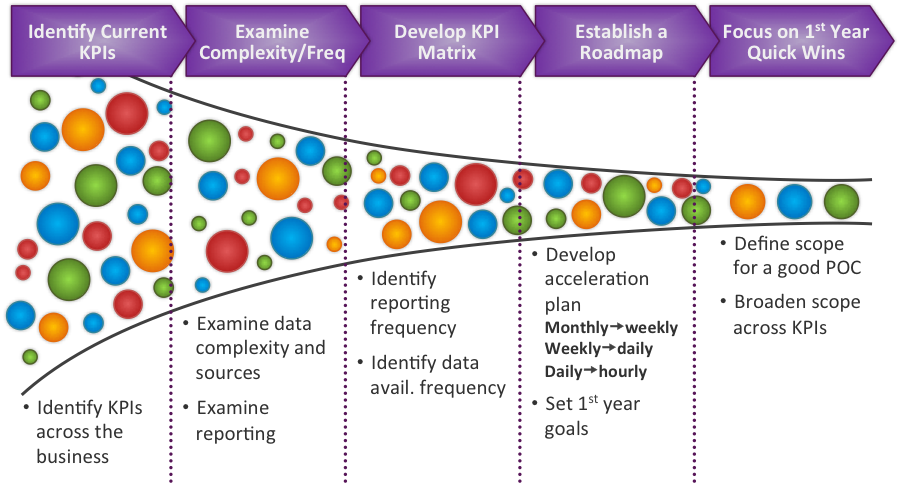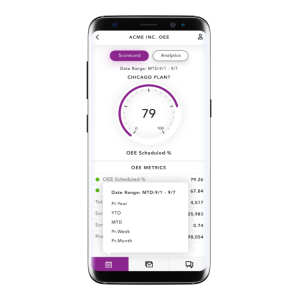
30 Jul From 50 KPI’s to 10: Moving from Static to Real-time KPIs
Rethinking your company’s KPI strategy – From 50 KPI’s to 10
A recent study by The Advanced Performance Institute entitled 20 Years of Measuring and Managing Business Performance revealed the fact that less that 20% of companies state everyone obtains regular insights (usually using Key Performance Indicators, or KPIs) which improve day-to-day decision making at all levels.
The same study shows that senior management seems to benefit, but not everyone. Why is that? In my experience it stems from the fact that KPIs were meant for the “Senior Management Monthly Meeting” – containing a 50-slide Business Process Management Deck. To improve day-to-day decision making at all levels, organizations must rethink KPIs and focus on reducing the number of KPIs to individuals while moving from static to more real-time KPIs. The basic concept is to fight information overload and ensure the right KPIs are delivered to the right people at the right time.
Here are three things to consider when rethinking your KPI strategy and moving from static to real-time KPIs:
1. KPI Real-Time Maturity.
Is the organization ready for real-time KPIs? They key issues are:
- Can specific individuals within your organization handle and manage to these metrics?
- Can the data sources which KPIs are derived from be accessible?
One way to assess this is to define your KPIs, their source, their refresh frequency and review-frequency by the organization. Once you have this “KPI Inventory”, they can be grouped by organization (users of the KPIs) and refresh/review frequency for better determining how to redesign your business metrics, which is another item to consider.
2. Redesign your business metrics.
This can include newer KPIs and/or the frequency of refresh and use. Can quarterly KPIs migrate to monthly, monthly to weekly, weekly to daily, and daily to real-time? Using the above maturity criteria, can the data which feeds these KPIs be accessed on such a basis? Can visibility and/or ability to react to your new set of real-time KPIs drive better business value? Finally, can your organization handle these KPIs in real-time?
Here are two example of a redesign of business metrics:
New Key Performance Indicators
While profitability is usually measured on a quarterly or monthly basis at the corporate level, organizations can better drive profitability by understanding profitability by product on a “cost-per” basis as product is in the manufacturing stage. Some products where yields or fluctuations in raw material quality can drive costs up or down can have a material impact on corporate profitability. When managing all products by “cost-per” KPIs across the organization and in real-time, corporate profitability drivers can be much better understood.
A KPI which drives business value going from weekly to real-time.
In some supply chains where environmental compliance can be a large factor both in terms of profitability and in public perception, managing KPIs such as waste recycling rate, carbon footprint and water footprint to a real-time level can enable organizations to better manage to their green metrics.
3. KISS – Keep it Short and Simple.

Real-time information allows you to reduce the number of KPIs used to manage the business. The 50 slide BPM deck in many cases is no longer needed. While real-time KPIs can benefit everyone in an organization, each team member needs to remain focused on a specific set pertinent to their role, level and ability to respond to real-time KPIs. Therefore simplification needs to be the theme – short, simple and easy to access and review. We designed our One View dashboard to allow for a “shallow dive,” so you only see KPIs that matter in real time.
In summary, reducing and migrating some KPIs to a real-time nature can drive business benefits by empowering all levels of an organization and direct supply chain improvements.
[optin-monster-inline slug=”qloggraxd3payfghmxer”]
A roadmap to creating a real-time KPI dashboard
- Assess current KPIs by business function, role and department
- Consider real-time readiness and maturity, in context of people and data sources
- Create a KPI roadmap and action plan; prioritize by readiness and business value
- Choose the “best” KPIs and commit the right resources
- Develop a strategy to move from static metrics to relevant real-time KPIs
Learn more from our webinar presented in conjunction with Epicor, “From 50 KPIs to 10.”
See the video >


